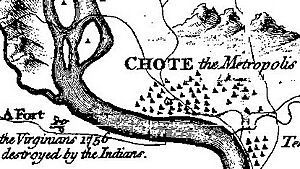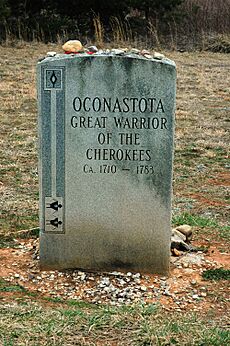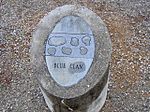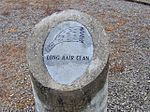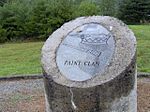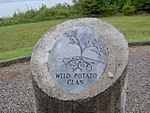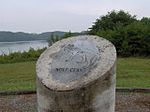Chota (Cherokee town) facts for kids
Quick facts for kids |
|
|
Chota and Tanasi Cherokee Village Sites
|
|
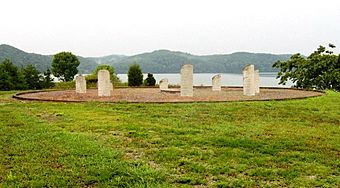
Monument at the Chota site
|
|
| Location | Monroe County, Tennessee |
|---|---|
| Nearest city | Vonore |
| Built | c. 1600-1745 A.D. |
| NRHP reference No. | 73001813 |
| Added to NRHP | 1973 |
Chota (pronounced Cho-tah) was a very important town for the Cherokee people. It was located in what is now Monroe County, Tennessee, in the southeastern United States. For many years, Chota was the main capital, or "mother town," of the Cherokee nation. It became more important than the nearby town of Tanasi in the 1740s. Chota remained the capital until 1788.
Many famous Cherokee leaders lived in Chota. These included Attakullakulla, Oconostota, Old Hop, Old Tassel, Hanging Maw, and Nancy Ward.
Today, the sites of Chota and Tanasi are listed together on the National Register of Historic Places. This means they are important historical places. Since 1979, most of both sites have been covered by Tellico Lake. This lake was created when the Tellico Dam was built on the Little Tennessee River. Before the dam was finished, archaeologists carefully dug up and studied the sites.
During these digs, they found the spot where the Chota townhouse stood. Major Cherokee towns had a large townhouse or council house. This was where hundreds of people met for community events. These houses were usually built on top of an old platform mound. These mounds were often built by earlier groups of people.
Before Tellico Lake was filled, the Chota townhouse site was raised. This kept it above the water level. A path was built to connect it to the land. The Chota monument now stands over the old townhouse site. It has eight pillars. Seven pillars stand for each of the seven Cherokee clans. The eighth pillar represents the entire Cherokee nation. The grave of Chief Oconostota was found during the digs in 1969. His remains were reburied next to the monument. The Eastern Band of Cherokee Indians now manages this important site.
Contents
Where were Chota and Tanasi located?
The Little Tennessee River starts in the Appalachian Mountains. It flows for about 50 miles (80 km) through parts of Tennessee. It then joins the Tennessee River. Tellico Lake was formed when the Tellico Dam was completed in 1979. This lake covers the lower 33 miles (53 km) of the river. The Chota site is about 27 miles (43 km) upriver from where it joins the Tennessee River. It is across from a sharp bend in the river called Bacon's Bend.
Both Chota and Tanasi were built on flat land next to the river. Steep hills rise to the south of these sites. These hills are part of the Appalachian Ridge-and-Valley area. This area has long, narrow ridges and steep hills. The Great Smoky Mountains and the Unicoi Mountains are a few miles away.
You can find the Tanasi and Chota monuments off Highway 360. A short path leads from a parking lot to the Chota monument.
What is the history of Chota?
How did Chota become important?
The town of Tanasi is first mentioned in old records from the early 1700s. English traders and diplomats often visited Tanasi. Tanasi appears on maps of the Cherokee Overhill territory from the 1720s and 1730s. Chota, however, does not appear on these maps. This might mean Chota was part of Tanasi back then. Or it might not have been a separate town yet. In the 1720s, the leader of Tanasi was the main chief of all the Overhill Cherokee towns.
In 1730, a Cherokee leader named Moytoy of Tellico was crowned "Emperor of the Cherokee." This happened with help from an English visitor, Alexander Cuming. This made Moytoy's town, Great Tellico, the main capital. When Moytoy died in 1741, his son tried to take his place. But Conocotocko, also known as Old Hop, was the leader at Chota. He began to gain more power. By 1753, Chota had taken over from Great Tellico as the "mother town" of the Overhill Cherokee.
Around this time, the French and Indian War was about to begin. The Cherokee seemed to be leaning towards the French side. So, the English colonies of Virginia and South Carolina wanted to make friends with the Overhill towns. Virginia sent Major Andrew Lewis to build a fort at Chota. It was finished in August 1756. The fort was never used by soldiers. This was because the Cherokee decided to ally with the English against the French. Later that year, South Carolina sent people to build Fort Loudoun. This fort was completed in March 1757 on the Little Tennessee River.
By 1760, relations between the British and Cherokee got worse. This led to a war in February. Cherokee warriors surrounded Fort Loudoun. Then, 14 Cherokee hostages were killed at another fort. After several months, the soldiers at Fort Loudoun gave up. The Cherokee killed many of them as they tried to return to Virginia. They also took valuable items from the fort to Chota.
What was Timberlake's visit like?
After Fort Loudoun fell, the British fought the Cherokee again. The Overhill towns then asked for peace. Peace was agreed upon in 1761. Virginia sent a group led by Henry Timberlake to make sure peace lasted. He arrived at Chota in late December 1761. He was with Ostenaco, a Cherokee leader from Tomotley. At a ceremony in the Chota townhouse, Ostenaco buried a hatchet. This showed peace between the British and Cherokee. Everyone smoked special peace pipes. Timberlake stayed the night in Old Hop's "hot-house." This was a round home used by the Cherokee in winter.
Timberlake wrote a journal about his trip. He also drew a detailed map of the Cherokee towns. This map was called "Draught of the Cherokee Country." It showed 52 homes and a townhouse in Chota. He listed the chiefs, warriors, and people for each town. Old Hop was listed as the leader of both Chota and Tanasi. Chota had 175 warriors. This was the second-largest group among the Overhill towns.
Why did Chota decline?
When the American Revolutionary War started, the Cherokee sided with the British. They hoped to force American settlers out of their land. In 1776, some Cherokee leaders attacked American settlements. In response, Virginia sent soldiers to fight the Overhill towns. The soldiers entered the Little Tennessee Valley without a fight. They made a truce with chiefs Attakullakulla and Oconastota. But one leader, Dragging Canoe, refused to make peace. So, the soldiers destroyed several towns, including Great Tellico and Toqua.
In 1780, John Sevier led another attack on the Overhill country. This was because the Cherokee had attacked American settlements. His group destroyed most of the remaining Overhill towns, including Chota.
The Cherokee rebuilt Chota by 1784. But it never became as important as it once was. In 1788, Old Tassel, who was the leader of the Overhill towns, was killed. He was murdered by Americans while under a flag of truce. Because of this terrible event, the Chickamauga Cherokee moved their capital further south to Ustanali.
In the late 1790s, the Duke of Orleans visited an American fort called Tellico Blockhouse. While there, he watched over 600 Cherokees play a traditional "ballplay" at Chota. He even bet on the game! By this time, only five homes were left standing in the town.
What did archaeologists find at Chota?
In the 1880s, Cyrus Thomas studied ancient earthwork mounds in the Little Tennessee Valley. He worked for the Smithsonian Institution. Thomas dug into a mound at the Chota site. He found several old items. The site was not disturbed again for many years.
In 1939, a team from the University of Tennessee dug at the Chota site. They found 85 pits, 12 burials, and one building.
In 1967, the Tennessee Valley Authority planned to build Tellico Dam. This dam would flood several historic Cherokee sites. So, the University of Tennessee started a project to dig up and save historical items. They dug at Chota between 1969 and 1974. They found 783 pits, the outlines of 31 buildings, and 91 burials. One burial, found in 1969, was identified as Chief Oconostota. This was because of items found with him, like wire glasses. Thousands of stone and pottery items were also found. These included tools dating back to 8000–1000 B.C.
The archaeologists found two townhouses at Chota. One was 60 feet (18 m) across, and the other was just over 50 feet (15 m) across. The smaller, older townhouse might have been the Tanasi townhouse. Other structures included a summer building and a large village plaza. They also found 11 pairs of rectangular summer homes and circular winter homes. Homes were spaced 40 to 100 feet (12 to 30 m) apart. Some were up to 2,000 feet (610 m) from the townhouse. One home was from the early Mississippian culture (around 1000–1300 A.D.). The others were from the historic Cherokee period.
In 1986, the burials found at Chota were reburied. They were placed in a burial mound at the Sequoyah Museum. This museum is near Vonore. The only exception was Oconostota's remains. They were buried next to the Chota monument, as the Cherokee wished.
Chota monument
The eight pillars stand for the seven clans and one for the Cherokee nation as a whole.


